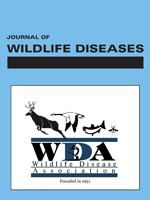A field study was conducted to determine the prevalence of conjunctivitis and Mycoplasma gallisepticum (MG) infections in house finches (Carpodacus mexicanus) and other songbirds common to bird feeders in Tompkins County (New York, USA). Eight hundred two individuals of 23 species and nine families of birds were captured and given physical examinations during the 14 mo study beginning in February 1998. Clinical conjunctivitis (eyelid or conjunctival swelling, erythema, and discharge) was observed in 10% (19/196) of house finches examined, and only in the winter months from November to March. Unilateral conjunctivitis was observed in 79% (15/19) of affected house finches; one case developed bilateral disease between 8 and 18 days following initial examination. Conjunctivitis was observed in a similar proportion of males and females sampled, and body condition scores and wing chord lengths were not significantly different between diseased and non-diseased house finches. Mycoplasma gallisepticum was isolated from 76% (13/17) of finches with conjunctivitis and 2% (3/168) of clinically normal house finches sampled during the study. DNA fingerprints of 11 MG isolates using random amplification of polymorphic DNA (RAPD) techniques showed no apparent differences in banding patterns over the course of the study, suggesting persistence of a single MG strain in the study population. The prevalence of conjunctivitis and MG infections declined in house finches between February/ March 1998 and February/March 1999 (23% to 6%, and 20% to 5%, respectively), but only the former was significant (P < 0.05). Conjunctivitis was also observed in four American goldfinches (Carduelis tristis) and one purple finch (Carpodacus purpureus). Mycoplasma gallisepticum infection was confirmed in the purple finch, the first documented case of MG-associated conjunctivitis in this species. The purple finch isolate was similar to house finch isolates from the study site by RAPD analysis. Positive plate agglutination (PA) tests were recorded in one other goldfinch and two purple finches, suggesting exposure of these individuals to MG. Positive PA tests were also obtained from two brown-headed cowbirds (Molothrus ater) and four tufted titmice (Parus bicolor), but MG infection could not be confirmed in these cases due to lack of samples. Based on these findings, the prevalence of MG infections in hosts other than house finches appear to be low in the population sampled. There is growing evidence, however, that songbird species other than house finches are susceptible to MG infection and disease.
How to translate text using browser tools
1 April 2000
MYCOPLASMAL CONJUNCTIVITIS IN SONGBIRDS FROM NEW YORK
Barry K. Hartup,
George V. Kollias,
David H. Ley

Journal of Wildlife Diseases
Vol. 36 • No. 2
April 2000
Vol. 36 • No. 2
April 2000
Carpodacus mexicanus
Carpodacus purpureus
conjunctivitis
host range
House Finch
Mycoplasma gallisepticum
mycoplasmosis




